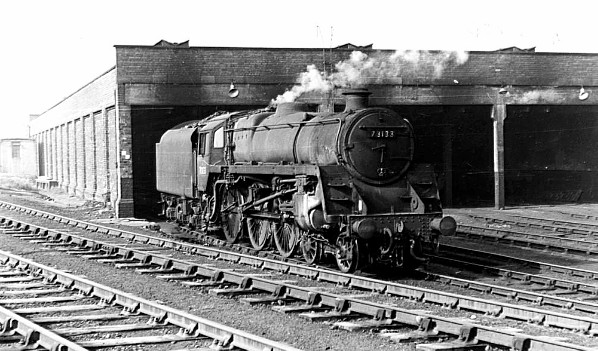
On 12 October 1963 BR Standard Locomotive number 73133 stands outside Widnes Locomotive Shed awaiting its next turn of duty. In the foreground is the double track spur that connected the Widnes Deviation to the St Helens line.
Photo by I G Holt
In the early years of the St Helens & Runcorn Gap Railway it is likely that the locomotives that serviced the southern end of the line were stabled at Sutton. However with the expansion of industry at Widnes from the 1840s onwards there most have been a need to stable engines locally. It is known that local factories had engines of their own for use on their systems and that these were stabled in simple wooden sheds. By the time that the London & North Western Railway (LNWR) took over what had become the St Helens Canal & Railway company on the 31st of July 1864 Widnes had become a major industrial centre.
.jpg)
The Widnes Locomotive Shed shown on a 1893 map.
The LNWR set about improving the railway at Widnes. One of the major issues was a flat crossing and junctions between the St Helens line and the line between Garston and Warrington which was called 'Widnes Dock Junction'. To improve the congestion caused by the flat crossing the LNWR built a new line, the Widnes Deviation, which branched off the Garston and Warrington line to the west (at West Deviation Junction) of the St Helens line passed over it and then rejoined the Garston and Warrington to the east (at Carterhouse Junction). A spur was put in between the deviation. it branched off from the deviation to the east of the new Widnes passenger station. The spur dropped down to the level of the St Helens line and formed a junction with it at the point where it passed under the deviation. The spur allowed St Helens line trains to use the new station. The deviation and spur opened in November 1869 to goods services with passenger trains starting to use it from 1 March 1870 when the new Widnes station opened.
In the space between the spur and the deviation the LNWR built the Widnes Locomotive Shed which to which it allocated the code 35W. The shed had three roads and in 1873 it was approved to accommodate six locomotives. At first the shed had no turntable and only basic facilities. By 1879 there were 26 locomotives allocated to Widnes so some additional external storage lines must have been added. Certainly by 1890 the shed had developed into a six road shed that had a turntable and a coaling facility. Also to the south of the St Helens line spur additional sidings had been laid that were used for locomotive stabling. It was in this form that the shed would remain up until closure.
The main shed building fronted onto Alforde Street a narrow north/south thoroughfare which passed under both the 'Deviation' line and the St Helens spur. Facing onto the street was staff accommodation and offices. Behind them was the engine shed. Its south wall was very close to the St helens line spur. The six roads led out of the shed and merged into a single line that joined the St Helens line spur just before its junction with the line down to Widnes Dock. A signal box, Widnes No. 3 controlled the junction between the shed and the spur line.
Leading off from the northern most shed road was a line that ran to the north of the shed right up to Alforde Street where it ended adjacent to a brick wall at a higher elevation than the street and parallel to the Widnes Deviation line (which was in turn at a higher elevation). Leading off this line were two sidings that ran into the coaling at watering area, a line that ran to a turntable at the eastern end of the shed site. To the south of the turntable there was a further siding for stabling locomotives.
The duties performed by the Widnes based locomotives in the later part of the 19th Century would have been in the main goods turns but there were also passenger turns.
On 1 January 1923 the Widnes Motive Power Depot was taken over by the London, Midland and Scottish Railway (LMS). They allocated it the code 8D being a sub shed of Liverpool Edge Hill which was 8A.. By the time the LMS took over the shed had an allocation of thirty-five locomotives. Tank engines had been the usual type at Widnes since it had opened but that changed in the 1920s and by 1929 nearly half of the locomotives were tender types. During that year Widnes had four 2-4-2Ts, four 0-6-0Ts, eight 0-6-0STs, and a single 0-4-0T. It also had a dozen ex LNWR 0-6-0 'Cauliflowers' and seven ex LNWR 0-8-0s. Throughout the 1920s and 1930s the shed employed over 100 men.
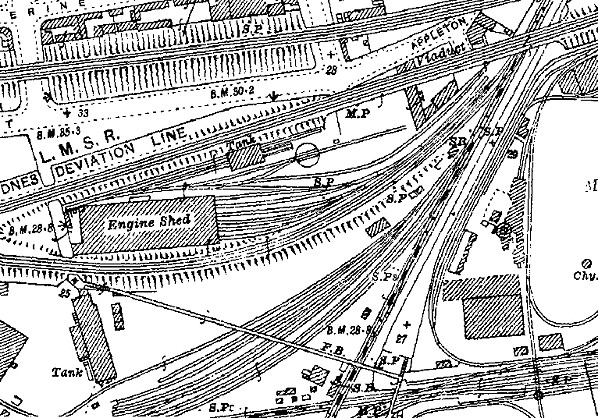
The Widnes Locomotive Shed '8D' shown on a 1927 map.
In 1937 the LMS enlarged the office accommodation at the western end of the shed building. As in the later part of the 19th Century the turns during the LMS era were mostly goods. The few passenger turns that there were included runs to Liverpool, Acton Bridge and to Manchester London Road.
During the Second World War the shed was extremely busy and the loco crews found themselves traveling further afield than they previously had done. In 1946 the LMS renewed the shed roof in the 'louvre' style.
On the 1st of January 1948 the shed became part of the nationalised British Railways (London Midland Region). British Railways kept the LMS shed codes and so Widnes remained as 8D. Widnes gained a sub shed at this time the former Great Central/Midland Railway Joint Shed at Tanhouse Lane which was situated half a mile to the east on a line that had no physical connection with the former LNWR network (other than via private factory sidings). Little changed in terms of the duties that Widnes based locomotives performed but the number of allocated locomotives had dropped to twenty-five by 1948. They included eleven ex LNWR types mainly 0-6-0s and 0-8-0s. LMS 2MT Mogals had begun to arrive by then and became a feature of the shed. Eight ex LMS 8Fs had also been allocated to Widnes along with an Ivatt 2-6-2T.
In the 1950s there was a great deal of local trip working and runs to Gorton, Wigan Springs Branch and Liverpool. On 16 April 1954 the shed at Tanhouse Lane was closed and in 1956 it was demolished. Railway staff continued to have a base at Tanhouse Lane but locomotive crews had to walk there from the main shed a distance of about half a mile. On 16 March 1961 a spur was put in between the Widnes and St Helens line and Tanhouse Yard with allowed the easy transfer of locomotives between the two systems. By the late 1950s Widnes had two 350hp diesel shunters numbers D3793 and D3794. No fueling point was installed for them and they had to travel to Garston for refueling. Shown in the tables below are records of locomotives seen on shed at Widnes on Sunday 19 April and Sunday 10 May 1959 by Roy Gough.
| Locomotive on Shed 19 April 1959 |
Locomotive Type |
Locomotive on Shed 19 April 1959 |
Locomotive Type |
| 48291 |
Stanier 8F 2-8-0 (Ex LMS) |
47616 |
Fowler 3F 0-6-0T (Ex LMS) |
| 48771 |
Stanier 8F 2-8-0 (Ex LMS) |
73035 |
Standard 5MT 4-6-0 BR |
| 48554 |
Stanier 8F 2-8-0 (Ex LMS) |
48425 |
Stanier 8F 2-8-0 (Ex LMS) |
| 65157 |
Class J10 2F 0-6-0 (Ex NE) |
40137 |
Stanier 3MT 2-6-2T (Ex LMS) |
| 48709 |
Stanier 8F 2-8-0 (Ex LMS) |
90254 |
Austerity 8F 2-8-0 (W-D) |
| 78032 |
Standard 2MT 2-6-0 BR |
80040 |
Standard 4MT 2-6-4T BR |
| 44250 |
Fowler 4F 0-6-0 (Ex LMS) |
48558 |
Stanier 8F 2-8-0 (Ex LMS) |
| 48502 |
Stanier 8F 2-8-0 (Ex LMS) |
48749 |
Stanier 8F 2-8-0 (Ex LMS) |
| 78034 |
Standard 2MT 2-6-0 BR |
65184 |
Class J10 2F 0-6-0 (Ex NE) |
| 48753 |
Stanier 8F 2-8-0 (Ex LMS) |
48506 |
Stanier 8F 2-8-0 (Ex LMS) |
| 78033 |
Standard 2MT 2-6-0 BR |
40143 |
Stanier 3MT 2-6-2T (Ex LMS) |
| 48697 |
Stanier 8F 2-8-0 (Ex LMS) |
65198 |
Class J10 2F 0-6-0 (Ex NE) |
| 40134 |
Stanier 3MT 2-6-2T (Ex LMS) |
47490 |
Fowler 3F 0-6-0T (Ex LMS) |
| 78039 |
Standard 2MT 2-6-0 BR |
51218 |
Aspinall 0F 0-4-0ST (Ex L&Y) |
| Locomotive on Shed 10 May 1959 |
Locomotive Type |
Locomotive on Shed 10 May 1959 |
Locomotive Type |
| 40134 |
Stanier 3MT 2-6-2T (Ex LMS) |
48502 |
Stanier 8F 2-8-0 (Ex LMS) |
| 48166 |
Stanier 8F 2-8-0 (Ex LMS) |
40143 |
Stanier 3MT 2-6-2T (Ex LMS) |
| 47490 |
Fowler 3F 0-6-0T (Ex LMS) |
48697 |
Stanier 8F 2-8-0 (Ex LMS) |
| 48175 |
Stanier 8F 2-8-0 (Ex LMS) |
65198 |
Class J10 2F 0-6-0 (Ex NE) |
| 78039 |
Standard 2MT 2-6-0 BR |
65175 |
Class J10 2F 0-6-0 (Ex NE) |
| 80091 |
Standard 4MT 2-6-4T BR |
51218 |
Aspinall 0F 0-4-0ST (Ex L&Y) |
| 48425 |
Stanier 8F 2-8-0 (Ex LMS) |
65184 |
Class J10 2F 0-6-0 (Ex NE) |
| 78035 |
Standard 2MT 2-6-0 BR |
78033 |
Standard 2MT 2-6-0 BR |
| 48308 |
Stanier 8F 2-8-0 (Ex LMS) |
40137 |
Stanier 3MT 2-6-2T (Ex LMS) |
| 48735 |
Stanier 8F 2-8-0 (Ex LMS) |
47616 |
Fowler 3F 0-6-0T (Ex LMS) |
| 48326 |
Stanier 8F 2-8-0 (Ex LMS) |
78034 |
Standard 2MT 2-6-0 BR |
| 48771 |
Stanier 8F 2-8-0 (Ex LMS) |
78032 |
Standard 2MT 2-6-0 BR |
In 1961 Widnes shed still had passenger work to Liverpool Lime Street, to Ditton Junction and to Manchester Oxford Road. The shed also had a working from Ditton Junction to Helsby which departed from Ditton at 6.05am.
Some of the goods turns in the early 1960s are shown in the tables below. Local trips were known as 'targets'.
| Target Number |
Destination/task |
| T81 |
Banking duties between Vine Yard and Farnworth & Bold. |
| T85 |
Shunting at Marsh Sidings (Widnes Dock). |
| T86 |
Farnworth and Bold with wagons for Everite Works and Spence Works and return with empties. |
| T87 |
Shunting at Hutchinson Street Yard. |
| T88 |
Shunting at Hutchinson Street Yard. |
| T90 |
Hutchinson Street Yard to Marsh Sidings. |
| T92 |
Widnes Deviation Yard to Folly Lane with coal wagons. |
| T93 |
Shunting at Widnes Dock Junction. |
| T96 |
Ditton Sleeper Yard. |
| T99 |
Shunting at Ditton Junction. |
| Working |
Description |
| Marsh Sidings (Widnes Dock) to Bickershaw Colliery and return |
Empty coal wagons from the Marsh sidings to Bickershaw Colliery. Shunting at the colliery reception sidings then return to Marsh sidings with loaded wagons. |
| Bolton Trinity Street to Widnes Deviation |
Train crew traveled to Bolton Trinity Street as passengers. At Bolton they relieved a Yorkshire crew from a loaded coal train and brought it to Widnes Deviation. |
| Widnes to Heaton Mersey |
Eastbound coal empties for Yorkshire with Widnes Crew being relieved at Heaton Mersey. |
| Runcorn Folly Lane to Northwich |
Chemical tanks from the ICI sidings at Runcorn Folly Lane to ICI at Northwich. |
| Widnes Marsh Sidings to Leeds |
Mixed goods to Leeds with Widnes crew being relieved in Manchester area. |
| Northwich to Widnes Dock Junction |
Sand train from the Stoke area to St Helens Ravenhead. |
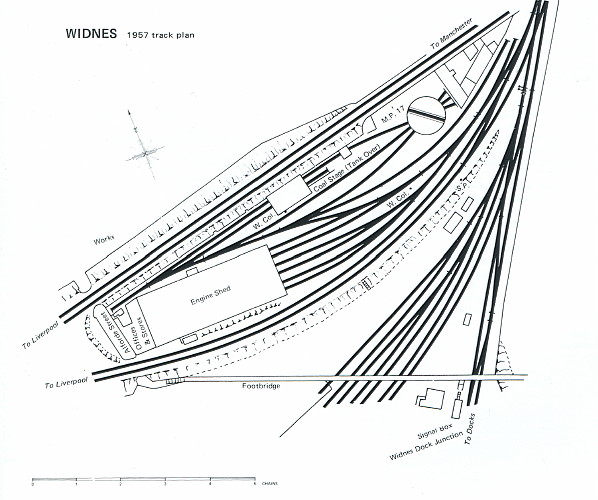
In 1961 Widnes Locomotive Shed was providing locomotives and crews at weekends for works associated with the electrification of the West Coast Main Line which was then in progress. Gradually though the numbers of Locomotives declined and the shed closed on 13 April 1964. Locomotive crews were offered transfers to other sheds in the area such as Speke and Warrington.
The shed stood in a derelict condition until 1974 (although the track had been removed by 1970) when it was sold to a scrap merchant who demolished all but the outer walls. The St Helens line from Widnes No. 2 to Widnes Dock closed on 4 November 1968 and from Widnes No. 7 to Widnes No. 1 on 18 April 1982 (the through route to St Helens having closed between Widnes No. 1 and Sutton Manor on 1 November 1981. In the mid 1990s a new road was built adjacent to the south wall of the shed which was still standing in 2012.
The 8D Association - Dedicated to promoting the history of South Lancashire and North Cheshire railways. Web Site
With thanks to Barry Nolan former fireman and to Colin Turton former passed cleaner at Widnes Locomotive Shed.
Sources:
See also: Ann Street Halt and Widnes South stations
And see feature:
Widnes Dock Junction
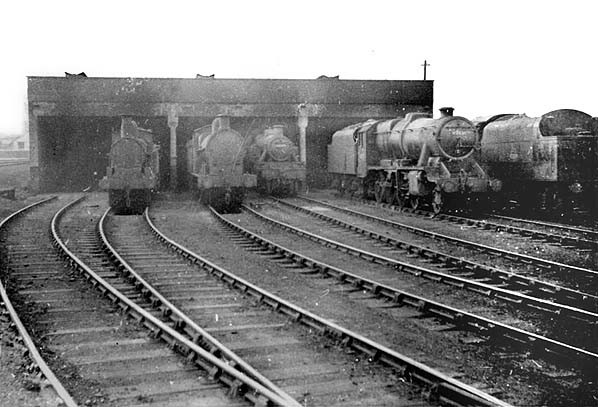
Looking west at Widnes Locomotive Shed in 1959.
Photo by J Peden
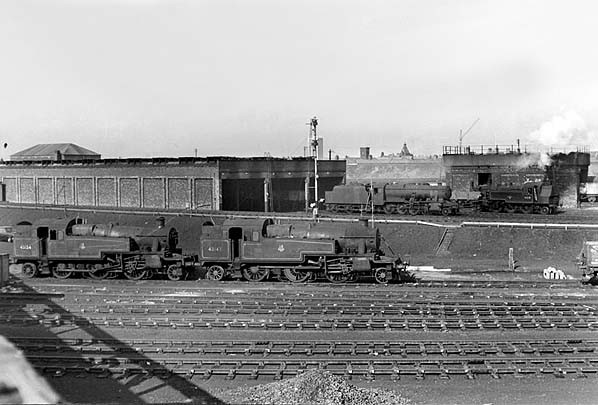
Looking north towards Widnes Locomotive Shed from the pedestrian footbridge at Widnes Dock Junction in January 1961. The shed can be seen in the distance beyond the St helens line spur which can be seen climbing up to the Widnes Deviation. In the foreground can be seen the double track that ran from the St Helens line (off view to the right) to the Garston line (off view to left) and which had before 1869 been used by all trains traveling between St Helens and Garston. Beyond it are the Widnes Dock Junction sidings which provided extra capacity for the stabling of locomotives.
Photo by E Bellas
.jpg)
Widnes shed on 20 September 1963. Locomotive number 48045 awaits its next duty.
Photo
by Brian Swinn
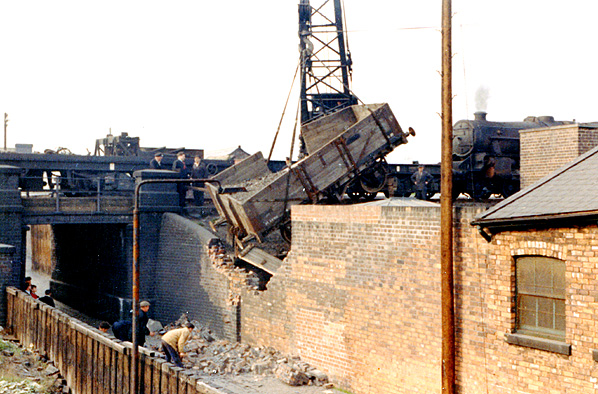
In June 1960 a wagon was accidently pushed throughthe wall at the rear of the shed and into Alforde Street. In this view the brakedown train is seen lifting the errant truck back into the depot whilst workmen clear away the demolished wall.
Photo by G Draper
.jpg)
The Widnes shed coaling area and water tank seen looking west on 7 August 1964.
Photo by Alan Robinson
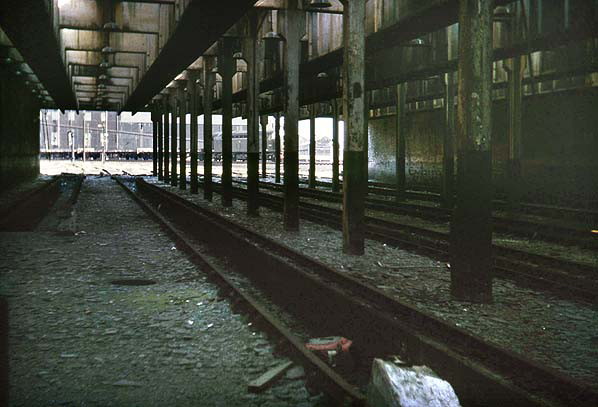
Looking east from inside Widnes Locomotive Shed in the late 1960s. Having seen its last locomotives in 1964 the shed was still standing at this time and would remain so until about 1974. In the distance on the spur leading up from the St Helens line to the Widnes Deviation can be seen an English Electric Type 4 Locomotive (later class 40) on a train of empty wagons.
Photo by Les Fifoot
.jpg)
Looking west along the Widnes Deviation line on 20 June 1990. To the left can be seen a scrap yard. The scrap yard was located on the site of the Widnes Locomotive Shed.
Photo
by John Wilson
.jpg)
The site of Widnes Locomotive Shed looking east on 4 January 2005. The wall in the foreground was part of the shed.
Photo
by Paul Wright
.jpg)
Looking west at the site of Widnes Locomotive Shed on 12 July 2012. The picture was taken from a similar viewpoint to the 1964 above but is looking more towards the site of the shed building.
Photo
by Paul Wright
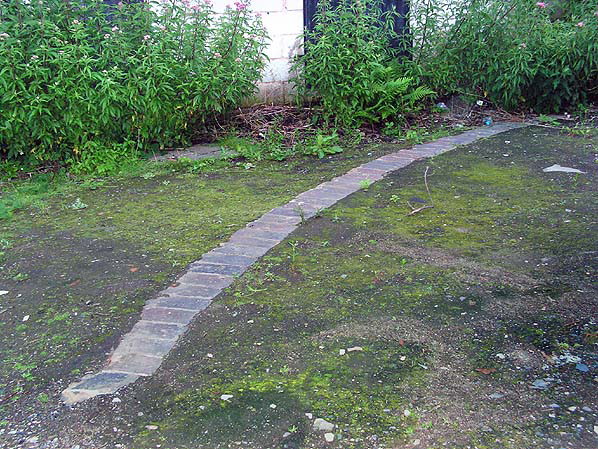
Brickwork from the edge of the turntable pit seen on 19 July 2012.
Photo
by Paul Wright
|

